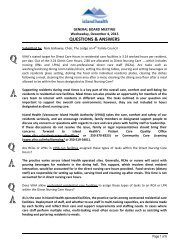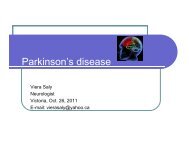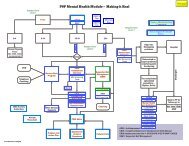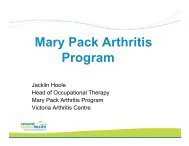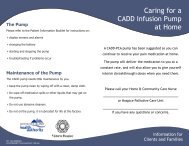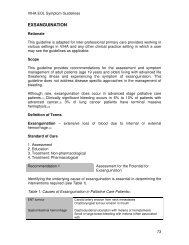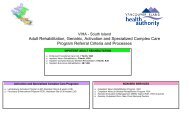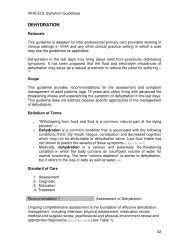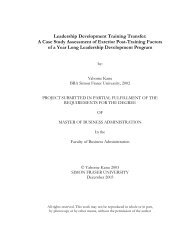BOWEL CARE
BOWEL CARE
BOWEL CARE
Create successful ePaper yourself
Turn your PDF publications into a flip-book with our unique Google optimized e-Paper software.
VIHA EOL Symptom Guidelines<br />
<strong>BOWEL</strong> <strong>CARE</strong><br />
Rationale<br />
This guideline is adapted for inter-professional primary care providers working in<br />
various settings in VIHA and any other clinical practice setting in which a user<br />
may see the guidelines as applicable.<br />
Scope<br />
This guideline provides recommendations for the assessment and symptom<br />
management of adult patients (age 19 years and older) living with advanced life<br />
threatening illness and experiencing the symptom of constipation. This guideline<br />
does not address disease specific approaches in the management of<br />
constipation.<br />
Bowel pattern changes cause distress in up to 18% of palliative care patients and<br />
rises to 80% or higher at the end of life.(1,2) Constipation is most frequent among<br />
patients treated with opioids – 40 to 50%.(3, 4) It significantly impacts quality of life<br />
and may be a cause of restlessness.(5) Constipation is more common in women<br />
and the elderly.(6) Diarrhea is less common occurring in less than 10% of cancer<br />
patients.(7, 8)<br />
Definition of Terms<br />
Constipation can be defined as “unduly infrequent and difficult evacuation of the<br />
bowels” that is “reduced frequency of bowel movements than is normal for the<br />
individual concerned, which may lead to pain and discomfort”.(9)<br />
Ingestion induced constipation results from inadequate intake of fluids and/or<br />
fiber or intake of constipating foods (cheese or milk) or by drugs.(1, 4) Other forms<br />
of constipation are:<br />
• hypotonic – caused by a decreased rate of water absorption and muscular<br />
tone<br />
• dyschezia (or habit) - caused by ignoring the urge to defecate<br />
• chronic hypertonic – caused by excess colonic muscular activity<br />
secondary to hypersegmentation and prominent creasing of feces (rather<br />
than propulsion) and fecal impaction (obstruction).(1)<br />
Diarrhea is defined as 3 or more loose, watery stools per day. (1, 8)<br />
Standard of Care<br />
1. Assessment<br />
2. Diagnosis<br />
3. Education<br />
4. Treatment: Non-pharmacological<br />
5. Treatment: Pharmacological<br />
15
VIHA EOL Symptom Guidelines<br />
Recommendation 1 Assessment of Constipation / Diarrhea<br />
Ongoing comprehensive assessment is the foundation of effective management<br />
of constipation, including interview, physical assessment (abdomen/bowel<br />
sounds/skin), medication review, medical and surgical review (x-ray of the<br />
abdomen may be indicated where obstruction is suspected), psychosocial<br />
review, review of physical environment and appropriate diagnostics (see Table<br />
1). Assessment must determine the cause, effectiveness and impact on quality of<br />
life for the patient and their family.(2, 7, 9-11) Complete a bowel assessment and<br />
consistently reevaluate.(1, 12) An excellent resource for guidance on interview<br />
questions for Constipation(13) and Diarrhea(14) can be found on the BC Cancer<br />
Agency website (www.bccancer.bc.ca > Health Professionals Info > Nursing ><br />
References > TelConsultProtocols).<br />
Table 1: Constipation/Diarrhea Assessment using Acronym O, P, Q , R, S, T , U<br />
and V *<br />
O Onset<br />
PProvoking /<br />
Palliating<br />
QQuality<br />
RRegion /<br />
Radiation<br />
SSeverity<br />
T Treatment<br />
UUnderstanding/<br />
Impact on You<br />
When did it begin? How long does it last? How often does it occur?<br />
History of bowel habits and patterns, usual time of defecations?<br />
Date of last bowel movement?<br />
What brings it on? What makes it better? What makes it worse?<br />
What has your diet been like – solids and fluids? What makes the<br />
stools softer/harder/watery, more/less frequent?<br />
What does it feel like? Can you describe it? What have the stools<br />
looked like? Do you have to strain? Flatulence?<br />
Does the feeling spread anywhere? Do you have any hemorrhoids,<br />
bleeding, pain?<br />
What is the intensity of this symptom (On a scale of 0 to 10 with 0<br />
being none and 10 being worst possible)? Right Now? At Best? At<br />
Worst? On Average? How bothered are you by this symptom? Are<br />
there any other symptom(s) that accompany this symptom? For<br />
example, pain, nausea/vomiting, bloating, loss of appetite?<br />
What medications and treatments are you currently using? If you<br />
are using laxatives, how effective are they? Do you have any side<br />
effects from the medications and treatments? What medications and<br />
treatments have you used in the past? What is your daily fluid and<br />
fibre intake?<br />
What do you believe is causing this symptom?<br />
How is this symptom affecting you and / or your family?<br />
16
VIHA EOL Symptom Guidelines<br />
What is your goal for this symptom? What is your comfort goal or<br />
V<br />
acceptable level for this symptom (On a scale of 0 to 10 with 0 being<br />
none and 10 being worst possible)? Are there any other views or<br />
Values<br />
feelings about this symptom that are important to you or your<br />
family?<br />
*also include a Physical Assessment (as appropriate for symptom)<br />
Recommendation 2 Diagnosis<br />
Identifying the underlying etiology of constipation and diarrhea is essential in<br />
determining the interventions required (see Tables 2 and 3).(6, 10, 11)<br />
Constipation can be multifactorial in nature.(10, 15, 16)<br />
Table 2: Causes of Constipation in Advanced Cancer Patients(1, 6, 7, 13)<br />
Structural<br />
abnormalities<br />
GI Obstruction<br />
Pelvic tumour mass<br />
Radiation fibrosis<br />
Painful anorectal conditions (anal fissure, hemorrhoids, perianal<br />
abscess)<br />
Drugs Opioids<br />
Drugs with anticholinergic action - anticholinergics,<br />
antispasmodics,<br />
antidepressants, phenothiazines, haloperidol, antacids<br />
Antiemetics – 5HT3 antagonists<br />
Diuretics<br />
Anticonvulsants<br />
Iron<br />
Antihypertensives<br />
Chemotherapy agents –vinca alkaloids<br />
Metabolic disturbances Dehydration<br />
Hyperglycemia<br />
Hypokalemia or Hypercalcemia<br />
Uremia<br />
Hypothyroidism<br />
Neurological disorders Cerebral tumours<br />
Spinal cord involvement/compression<br />
Sacral nerve infiltration<br />
Autonomic failure<br />
General Advanced age<br />
Inactivity<br />
Depression<br />
Sedation<br />
Decreased intake<br />
Low fiber diet<br />
Poor fluid intake<br />
Physical or social impediments<br />
Table 3: Causes of Diarrhea in Advanced Disease(1, 6, 7, 14)<br />
17
VIHA EOL Symptom Guidelines<br />
Obstruction Malignant tumour<br />
Fecal impaction<br />
Opioid bowel syndrome<br />
Drugs Laxatives<br />
Antacids<br />
Antibiotics<br />
Chemotherapy agents – 5-flourouracil, mitomycin<br />
NSAIDs – diclofenac, indomethacin<br />
Iron preparations<br />
Disaccharide containing elixirs<br />
Malabsorption Pancreatic carcinoma or insufficiency<br />
Gastrectomy<br />
Ileal resection<br />
Colectomy<br />
Tumour Cancer of the colon or rectum<br />
Pancreatic islet cell tumour<br />
Carcinoid tumour<br />
Radiation Abdominal or pelvic radiation with or without chemotherapy<br />
(RT induced enteritis)<br />
Concurrent disease Diabetes mellitus<br />
Hyperthyroidism<br />
Inflammatory bowel syndrome – Crohn’s<br />
Irritable bowel syndrome – Colitis<br />
Gastrointestinal infection – C. Difficile<br />
Diet Bran<br />
Fruit<br />
Hot spices<br />
Alcohol<br />
Recommendation 3 Education<br />
• Even in the absence of oral intake, the body continues to produce 1 to 2<br />
ounces of stool per day.(17)<br />
• It is not necessary to have a bowel movement every day. As long as<br />
stools are soft and easy to pass, every 2 to 3 days is acceptable.(12)<br />
• “Normal” bowel movements vary from person to person.(13)<br />
• If appetite is small, try to incorporate nutritious liquids such as milkshakes,<br />
cream soups, fruit juice.(13)<br />
• Encourage use of a bowel record to evaluate the effectiveness of<br />
treatment strategies. (27)<br />
• The desired outcomes of a treatment strategy is a comfortable bowel<br />
movement at least every several days with the minimum required use of<br />
laxatives as well as satisfaction of the patient and family. (27)<br />
18
VIHA EOL Symptom Guidelines<br />
Recommendation 4 Treatment Nonpharmacological<br />
Constipation:<br />
• Incorporate constipation prevention strategies for as long as possible and<br />
appropriate, including:<br />
– Encourage fluid intake of at least 5-6 eight ounce cups per day<br />
(unless medically contraindicated.) (27) Caffeinated and alcoholic<br />
beverages are not included in total daily fluid intake because of<br />
their diuretic effect. (27)<br />
– Encourage daily intake of natural dietary fibre (12-25 grams per<br />
day) (27) by increasing fruit (prunes), other natural agents, and/or<br />
dietary fiber (only for those with adequate fluid and mobility). (1, 3, 7, 11,<br />
15, 18, 19) A fruit laxative can be made with prunes, dates, figs and<br />
raisins.(10, 12) Fibre usually becomes effective after two to three days.<br />
(27)<br />
• Attempts at defecating should be made 30 to 60 minutes following<br />
ingestion of a meal to take advantage of the gastro colic reflex.(1, 10, 11)<br />
• Bowel action should be initiated when it is “normal and convenient” for the<br />
patient in a sitting position. It should be made easy to achieve quick<br />
access to a toilet when having the urge to defecate.(27) This can be<br />
facilitated by using; raised toilet seats, commodes and ensure adequate<br />
pain control for movement and comfort.(1, 10)<br />
• Provide privacy during toileting.(1, 3, 10, 11, 15, 19, 20)<br />
• Avoid excessive straining (this can complicate some medical conditions).(1,<br />
10) If possible, assist to allow leaning slightly forward on the toilet/commode<br />
with feet supported to reduce the need for straining. (27)<br />
• Encourage and assist with physical activity suited to the patient’s<br />
Diarrhea:<br />
abilities.(13,27)<br />
• For most patients with diarrhea decreasing fiber intake is helpful, however<br />
if there is excessive liquid in the bowel an absorbent can be helpful<br />
(crackers). If over stimulation of the bowel is suspected reducing intake to<br />
sips of fluid for 24 to 48 hours can be helpful.(1, 8)<br />
• Limit consumption of high fiber foods, large meals, fatty foods, caffeine (14)<br />
and dairy products.(6)<br />
• Maintain hydration and electrolytes as appropriate (particularly in cases of<br />
severe diarrhea).(1, 14) Ringers lactate is the preferred solution for<br />
parenteral hydration.(21) Rehydration can also be done orally, if the<br />
dehydration is not severe, with the WHO rehydration fluid (2 gm salt plus<br />
50 gm sugar to 1 litre of water).(8, 21)<br />
• A single liquid or loose stool usually does not require intervention.(1)<br />
19
VIHA EOL Symptom Guidelines<br />
• Good hygiene and application of hydrocolloid dressings(21) or barrier cream<br />
will help prevent excoriation with diarrhea.(1, 8) If already inflamed or<br />
excoriated use a corticosteroid cream for 1 to 2 days.(8)<br />
• Persisting diarrhea can have severe effects on image, mood and<br />
relationships, which will need support.(21)<br />
Recommendation 5 Treatment: Pharmacological<br />
Constipation:<br />
• Constipation is a common side effect of all opioids.(1, 12)<br />
• Patients often stop opioid therapy because of opioid induced<br />
constipation.(22)<br />
• Opioid induced constipation is much easier to prevent than treat.(23)<br />
• Opioids cause decreased motility (by suppression of intestinal peristalsis)<br />
and increased water and electrolyte re-absorption in the small intestine<br />
and colon.(1,4)<br />
• Transdermal fentanyl(4) and methadone(16, 20) have been shown to produce<br />
less constipation. Consider opioid rotation for severe refractory<br />
constipation.(16, 20)<br />
• Tolerance will not develop to the constipating effects of opioids.(15, 23)<br />
• The constipating effect of opioids are not dose dependant.(24)<br />
• Laxatives are available under the Palliative Benefit Program but require a<br />
prescription.<br />
• Consider patient preferences when determining bowel regime.(18)<br />
• In randomized clinical trial comparing senna to lactulose – senna was<br />
preferred secondary to a favorable toxicity profile and cost advantage.(25)<br />
The sweet taste of lactulose can cause problems with compliance.(7)<br />
Sorbitol has been found to be less nauseating.(6)<br />
• Start laxatives on a regular basis for all patients taking opioids(1, 12, 17, 19, 24)<br />
(see Appendix A).<br />
• Based on the bowel pattern, time since last bowel movement and bowel<br />
medication previously being used, determine the level of the bowel<br />
protocol for medications.(12)<br />
• Use a step wise approach, titrate the laxatives(1, 12, 16, 24) according to the<br />
bowel protocol to ensure regular bowel movements. Aim for soft formed<br />
stool at least once every 2 to 3 days.(12)<br />
• Three days without a bowel movement requires intervention.(1, 12)<br />
• The continued use of docusate in the palliative care setting is based on<br />
inadequate experimental evidence.(22, 26)<br />
• Rectal laxative should never accompany an inadequate prescription of<br />
oral laxative.(7)<br />
• Avoid use of rectal enemas and suppositories while receiving<br />
chemotherapy.<br />
• Avoid use of bulk forming agents (fiber) in patients with poor oral fluid<br />
intake. The patient must be able to tolerate 1.5 to 2 litres of fluid per day.(1,<br />
20
VIHA EOL Symptom Guidelines<br />
3, 11) This makes bulk forming agents a poor choice in cancer patients.(7)<br />
They may worsen with an incipient obstruction.(7)<br />
• Osmotic laxatives should be accompanied by an increase in fluid intake.(7)<br />
• Metoclopramide inhibits dopamine centrally and peripherally, therefore<br />
increasing peristalsis in the digestive tract and decreasing nausea and<br />
vomiting.(3)<br />
o Metoclopramide 10 to 20 mg PO q6h.(10)<br />
• There is some evidence to support the use of polyethylene glycol as a<br />
laxative for opioid induced constipation.(22) Polyethylene glycol 10 to 30 g<br />
PO daily to b.i.d. or 60 to 240 g for evacuation.(1)<br />
Oral Laxatives: Type : Action :<br />
Sodium docusate Predominantly softening –<br />
surfactant<br />
Lactulose Predominantly softening –<br />
osmotic laxative<br />
Sorbitol Predominantly softening –<br />
osmotic cathartic<br />
Methyl cellulose Predominantly softening –<br />
bulk forming agent<br />
Magnesium sulphate Predominantly softening –<br />
saline laxative<br />
Polyethylene glycol Predominantly softening –<br />
osmotic cathartic<br />
Sennosides Peristalsis stimulating –<br />
anthracenes<br />
Bisacodyl Peristalsis stimulating –<br />
polyphenolic<br />
Rectal Laxatives: Type : Action :<br />
Bisacodyl<br />
suppository<br />
Glycerin<br />
suppository<br />
Peristalsis stimulating –<br />
polyphenolic<br />
Predominantly softening –<br />
osmotic laxative<br />
Phosphate Enema Peristalsis stimulating –<br />
saline laxative<br />
Oil enema Predominantly softening –<br />
lubricant laxative<br />
Detergent, increase water<br />
penetration<br />
Retain water in small gut<br />
Retain water in small gut<br />
Normalize stool volume<br />
Retain water and strong<br />
purgative action<br />
Increases fluid and<br />
purgative action<br />
Reduces water and<br />
electrolyte absorption<br />
and purgative action<br />
Reduces water and<br />
electrolyte absorption and<br />
purgative action<br />
Evacuates stools from<br />
rectum or stoma:<br />
for colonic inertia<br />
Softens stools in rectum or<br />
stoma<br />
Evacuates stool from lower<br />
bowel<br />
Softens hard impacted stool<br />
• Latency of action of docusate sodium is one to three days.(7)<br />
• Latency of action of lactulose and sorbitol is one to two(6) and up to three<br />
days.(7)<br />
21
VIHA EOL Symptom Guidelines<br />
• Latency of action of peristalsis stimulating laxatives is 6 to 12 hours.(7)<br />
• Enemas may need to be repeated to clear the bowel of hard impacted<br />
stool.(7)<br />
• Latency of action of suppositories and enemas is 15 to 60 minutes.(6)<br />
Diarrhea:<br />
Diarrhea can be caused by over use of laxatives or can be a side effect of<br />
radiation, chemotherapy or surgical treatments.(1, 8, 21)<br />
Symptomatic relief is generally achieved with non-specific antidiarrheal agents –<br />
loperamide PO up to 16 mg daily(8) or codeine 10 to 60 mg PO q4h.(7) Unlike<br />
constipation, where multiple drugs are used simultaneously, a single drug should<br />
be used for diarrhea and care should be taken to avoid sub-therapeutic doses.(7)<br />
Metronidazole is recommended for C. Difficile diarrhea(6) - metronidazole 500 mg<br />
PO t.i.d.(8) Oral vancomycin is an alternative to metronidazole.<br />
Octreotide is an effective therapy for severe refractory diarrhea.(21) Octreotide 300<br />
to 600 mcg per day S.C.(21) in 2-3 divided doses.<br />
22
VIHA EOL Symptom Guidelines<br />
References<br />
Information was compiled using the CINAHL, Medline (1996 to April 2006) and<br />
Cochrane DSR, ACP Journal Club, DARE and CCTR databases, limiting to<br />
reviews/systematic reviews, clinical trials, case studies and guidelines/protocols<br />
using constipation/diarrhea terms in conjunction with palliative/hospice/end of<br />
life/dying. Palliative care textbooks mentioned in generated articles were hand<br />
searched. Articles not written in English were excluded.<br />
1. Carter B, Black F, Downing GM. Bowel Care - Constipation and Diarrhea. In: Downing GM, Wainwright<br />
W, editors. Medical Care of the Dying. Victoria, B.C. Canada: Victoria Hospice Society Learning Centre for<br />
Palliative Care; 2006. p. 341-62.<br />
2. McMillan SC. Presence and severity of constipation in hospice patients with advanced cancer. American<br />
Journal of Hospice and Palliative Care. November/December 2002;19(6):426-30.<br />
3. Tamayo AC, Diaz-Zuluaga PA. Management of opioid-induced bowel dysfunction in cancer patients.<br />
Support Care Cancer. 2004 June 19;12:613-8.<br />
4. Choi YS, Billings A. Opioid Antagonists: A Review of Their Role in Palliative Care, Focusing on Use in<br />
Opioid-Related Constipation. Journal of Pain and Symptom Management. July 2002;24(1):71-90.<br />
5. Goodman ML, Low J, Wilkinson S. Constipation Management in Palliative Care: A Survey of Practices in<br />
the United Kingdom. Journal of Pain & Symptom Management. March 2005;29(3):238-44.<br />
6. Sykes NP. An investigation of the ability of oral naloxone to correct opioid-related constipation in patients<br />
with an advanced cancer. Palliative Medicine. 1996;10:135-44.<br />
7. Fallon M, O’Neill B. ABC of palliative care: Constipation and diarrhoea. British Medical Journal. 1997<br />
November 15;315:1293-6.<br />
8. Waller A, Caroline NL. Diarrhea. Handbook of Palliative Care in Cancer. 2nd ed. Boston, MA; 2000. p.<br />
223-9.<br />
9. Goodman ML, Wilkinson S. Laxatives for the management of constipation in palliative care patients. The<br />
Cochrane Database of Systematic Reviews. 2006;1.<br />
10. Paolini CA. Symptoms Management at the End of Life. The Journal of the American Osteopathic<br />
Association. October 2001;101(10):609 - 15.<br />
11. Beckwith C. Evidence Based Symptom Control in Palliative Care: Constipation in Palliative Care<br />
Patients. Evidence Based Symptom Control in Palliative Care: Systematic Reviews and Validated Clinical<br />
Practice Guidelines for 15 Common Problems in Patients with Life Limiting Disease. 2000;8(1):47-57.<br />
12. British Columbia Cancer Agency. Suggestions for dealing with constipation – draft Management of<br />
Constipation - draft. British Columbia Cancer Agency; 2006.<br />
13. BC Cancer Agency Professional Practice Nursing. Telephone Consultation Protocol: Constipation. [cited<br />
2006 August2006];Protocol].Availablefrom:<br />
http://www.bccancer.bc.ca/HPI/Nursing/References/TelConsultProtocols/Constipation.htm<br />
14. BC Cancer Agency Professional Practice Nursing. Telephone Consultation Protocol: Diarrhea. [cited<br />
2006 August 2006];Protocol].Available from:<br />
http://www.bccancer.bc.ca/HPI/Nursing/References/TelConsultProtocols/Diarrhea.htm<br />
15. Esper P, Heidrich D. Symptom Clusters in Advanced Illness. Seminars in Oncology Nursing. February<br />
2005;21(1):20 - 8.<br />
16. Mancini IL, Hanson J, Neumann CM, Bruera E. Opioid Type and Other Clinical Predictors of Laxative<br />
Dose in Advanced Cancer Patients: A Retrospective Study. Journal of Palliative Medicine. 2000;3(1):49-56.<br />
17. Capital Health Regional Palliative Care Program. Bowel Care Protocol for Palliative Care Patients.<br />
March 20,2003[cited2006April2006]; Protocol].Available from:<br />
http://www.palliative.org/PC/ClinicalInfo/Clinical%20Practice%20Guidelines/PDF%20files/Bowel%20Care%2<br />
0in%20Palliative%20Care.pdf<br />
18. Cadd A, et al. Assessment and documentation of bowel care management in palliative care:<br />
incorporating patient preferences into the care regimen. Journal of Clinical Nursing. 2000;9:228-35.<br />
19. Waller A, Caroline NL. Constipation. Handbook of Palliative Care in Cancer. 2nd ed. Boston, MA:<br />
Butterworth-Heinemann; 2000. p. 197-206.<br />
20. Dean M, Harris JD, Regnard C, Hockley J. Constipation. Symptom Relief in Palliative Care. Oxford,<br />
United Kingdom: Radcliffe Publishing; 2006. p. 75-9.<br />
21. Dean M, Harris JD, Regnard C, Hockley J. Diarrhea. Symptom Relief in Palliative Care. Oxford, United<br />
Kingdom: Radcliffe Publishing; 2006. p. 81-4.<br />
23
VIHA EOL Symptom Guidelines<br />
22. Wirz S, Klaschik E. Management of constipation in palliative care patients undergoing opioid therapy: Is<br />
polyethylene glycol an option? American Journal of Hospice and Palliative Medicine. October<br />
2005;22(5):375-81.<br />
23. Ross DD, Alexander CS. Management of Common Symptoms in Terminally Ill Patients: Part II<br />
Constipation, Delirium and Dyspnea. American Family Physician. September 15, 2001;64(6):1019 - 26.<br />
24. Daeninck P, Crawford G. Constipation. In: MacDonald N, Oneschuk D, Hagen N, Doyle D, editors.<br />
Palliative Medicine – A case based manual 2nd ed. New York: Oxford University Press Inc.; 2005. p. 201-<br />
11.<br />
25. Agra Y, Sacristan A, Gonzalez M, Ferrari M, Portugues A, Calvo MJ. Efficacy of senna versus lactulose<br />
in terminal cancer patients treated with opioids. Journal of Pain & Symptom Management. 1998 Jan;15(1):1-<br />
7.<br />
26. Hurdon V, Viola R, Schroder C. How Useful is Dousate in Patients at Risk for Constipation? A<br />
Systematic Review of the Evidence in the Chronically Ill. Journal of Pain & Symptom Management. February<br />
2000;19(2):130-6.<br />
27. Harrigan Consulting. Best Practices for the Nursing Care of the Older Adult. Network of Excellence for<br />
Geriatric Services. VIHA – Clinical Practice Guidelines – Constipation – March 2006.<br />
Approved by: VIHA Quality Council July 2008<br />
24
VIHA EOL Symptom Guidelines<br />
Appendix A Example of an End of Life Bowel Protocol<br />
1. Complete Bowel Assessment.<br />
2. Determine Level at which to start, based on bowel pattern, time since last bowel<br />
movement and bowel medication use prior to admission. Record Level on<br />
appropriate form/flowsheet.<br />
3. Document all bowel medications administered and bowel movement information on<br />
the appropriate form/flowsheet and progress notes. Include frequency, character,<br />
and amount of bowel movements and laxative interventions.<br />
4. Subsequent rectal and/or abdominal examinations are to be documented on the<br />
appropriate form/flowsheet and progress notes.<br />
INDICATIONS CONTRAINDICATIONS<br />
• To prevent opioid-induced<br />
constipation.<br />
• To manage constipation where<br />
dietary measures have failed,<br />
or previous laxative treatment<br />
unsatisfactory.<br />
LEVEL 1 – PREVENTION<br />
ONCE DAILY (HS)<br />
LEVEL 2 – PREVENTION<br />
TWICE DAILY (BID)<br />
LEVEL 3 – CONSTIPATION<br />
MANAGEMENT<br />
No BM for 3 days or more. Do rectal<br />
examination and document appropriate<br />
form/flowsheet/progress notes.<br />
Do not follow protocol for:<br />
• Ileostomy.<br />
• Complete bowel obstruction.<br />
• Diarrhea.<br />
• Impaction if present, clear impaction prior to<br />
initiating protocol.<br />
• Short Bowel Syndrome.<br />
• If in doubt, contact MD.<br />
Meds:<br />
1. Sennosides 12 mg tablets; 12 to 36 mg (1 to 3 tablets)<br />
PO HS<br />
Meds:<br />
1. Sennosides 12 mg tablets; 24 to 36 mg (2 to 3 tablets)<br />
PO BID<br />
2. Lactulose 15-30 mL PO BID<br />
Continue previous medications PLUS: a, b or c<br />
(below)<br />
-----------------------------------------------------------------------------<br />
Meds:<br />
a) If soft stool in rectum<br />
Bisacodyl 10 mg supp PR. If not effective within 1 hour,<br />
give sodium citrate PR, e.g. Microlax®, or phosphate<br />
enema PR, e.g. Fleet®.<br />
b) If hard or impacted stool in rectum<br />
Oil Retention enema PR. If not effective within 1 hour,<br />
give sodium citrate or phosphate enema PR. Disimpact if<br />
indicated; considering analgesia prior to disimpaction.<br />
c) If no stool in rectum<br />
Perform abdominal examination and document on<br />
appropriate form. Assess abdomen for bowel sounds. If<br />
normal, give sodium citrate or phosphate enema PR +/-<br />
sodium phosphates oral. If abnormal, CALL MD or<br />
Hospice Palliative consultant (if available).<br />
OUTCOME: After a BM, resume Level I or II (increasing dose(s) PRN) to maintain a BM at least<br />
q 3 days<br />
25



